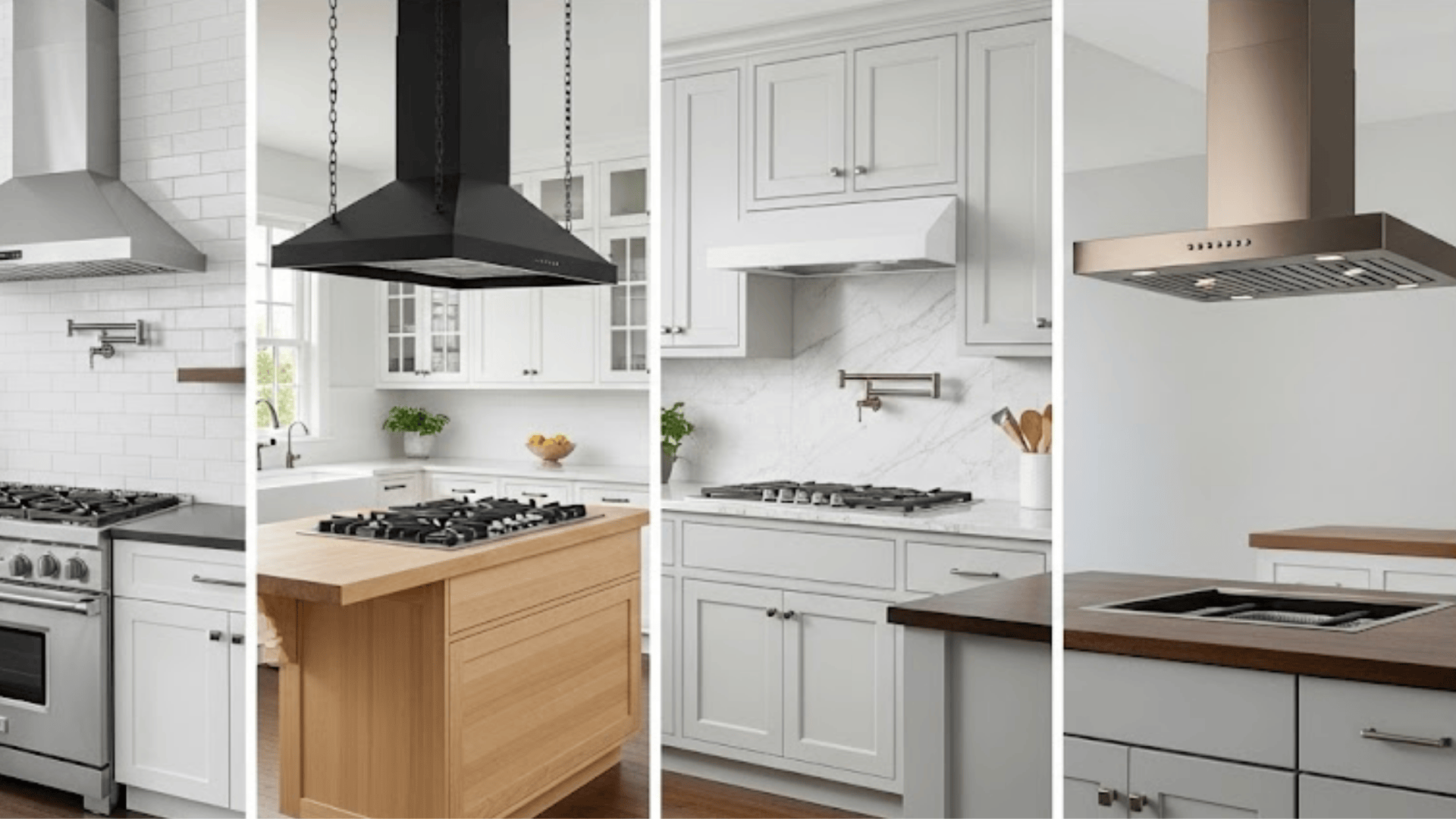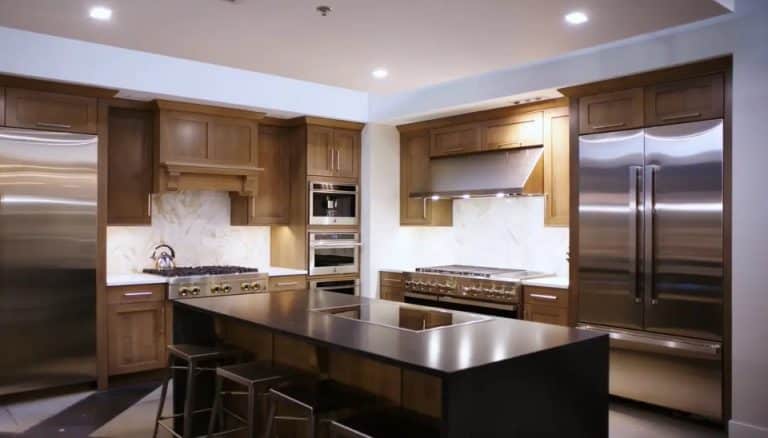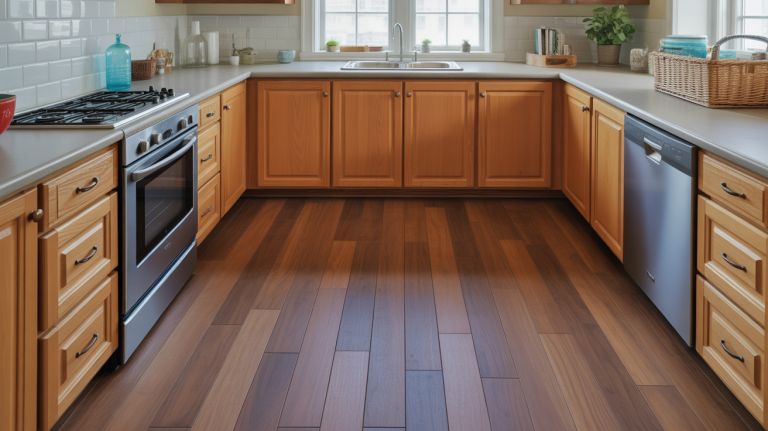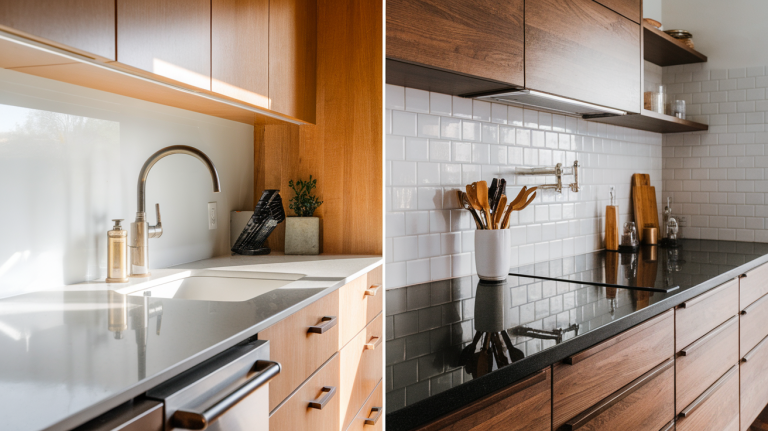8 Kitchen Exhaust Fan Types and How to Choose
Cooking fills your kitchen with smoke, grease, and lingering food odors. Without proper ventilation, these contaminants stick to surfaces and create unhealthy air quality.
Kitchen exhaust fans solve this problem by removing harmful vapors before they spread throughout your home. But with eight different types available, choosing the right one feels overwhelming.
This guide breaks down every range hood type, from space-saving under-cabinet models to robust commercial systems. You’ll learn which style fits your cooking habits, kitchen layout, and budget.
By the end, you’ll know exactly which kitchen ventilation system keeps your home clean, healthy, and odor-free while matching your specific needs perfectly.
Why Kitchen Ventilation Is Essential?
Poor kitchen ventilation creates serious problems for your home and health. Without proper airflow, cooking smoke, grease particles, and food odors get trapped indoors.
This leads to sticky surfaces, damaged cabinets, and poor air quality that can trigger breathing issues.
Kitchen ventilation systems remove these contaminants before they spread throughout your house.
While basic exhaust fans simply move air around, range hoods actively capture steam and grease right at the source above your stove.
This makes range hoods far more effective at protecting your kitchen surfaces and keeping your indoor air clean and fresh.
Factors to Consider Before Choosing
Key things to evaluate before selecting the right kitchen exhaust fan for your space and cooking needs.
- Kitchen Layout & Stove Location: Wall stoves need wall-mounted hoods, while island cooktops require ceiling-mounted units that won’t block sightlines.
- Cooking Habits & Frequency: Heavy frying and high-heat cooking demand powerful CFM ratings, while light cooking can work with basic models.
- Ducted vs Ductless: Ducted systems vent outdoors for better performance, while ductless models offer easier installation but less effective filtration.
- Aesthetics & Space Constraints: Choose between visible statement pieces or hidden under-cabinet models based on your kitchen’s style and available space.
- Budget & Installation Complexity: Basic under-cabinet units cost less and install easily, while custom island hoods require professional installation and a higher investment.
8 Kitchen Exhaust Fan Types for Better Airflow
A quick focus on 8 kitchen exhaust fan types to help you choose the best range hood for cleaner, fresher air in your cooking space.
1. Wall-Mounted Range Hood
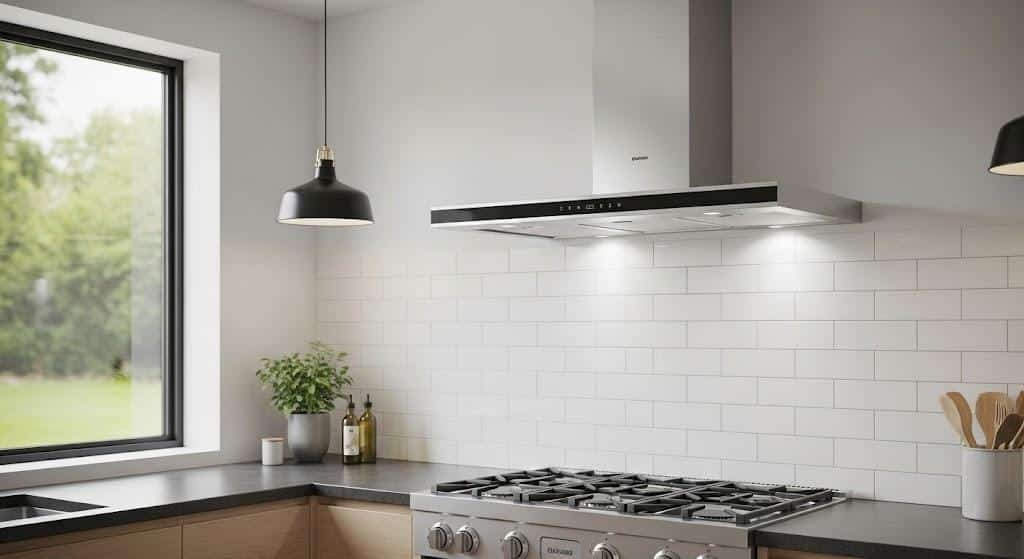
How it works: A wall-mounted kitchen exhaust fan attaches directly to the wall above your stove. It pulls cooking vapors up through internal fans and vents them outside or filters them through charcoal systems.
Design styles & materials: Available in stainless steel, copper, glass, and painted finishes. Styles range from modern flat designs to traditional chimney shapes. Popular options include pyramid, curved glass, and professional-style models.
| Pros | Cons |
|---|---|
| Strong suction power | Takes up wall space |
| Wide variety of styles | Visible design must match kitchen style |
| Easy to install on exterior walls | Requires wall mounting support |
| Good value for money | Limited to wall-adjacent stoves |
2. Under-Cabinet Range Hood
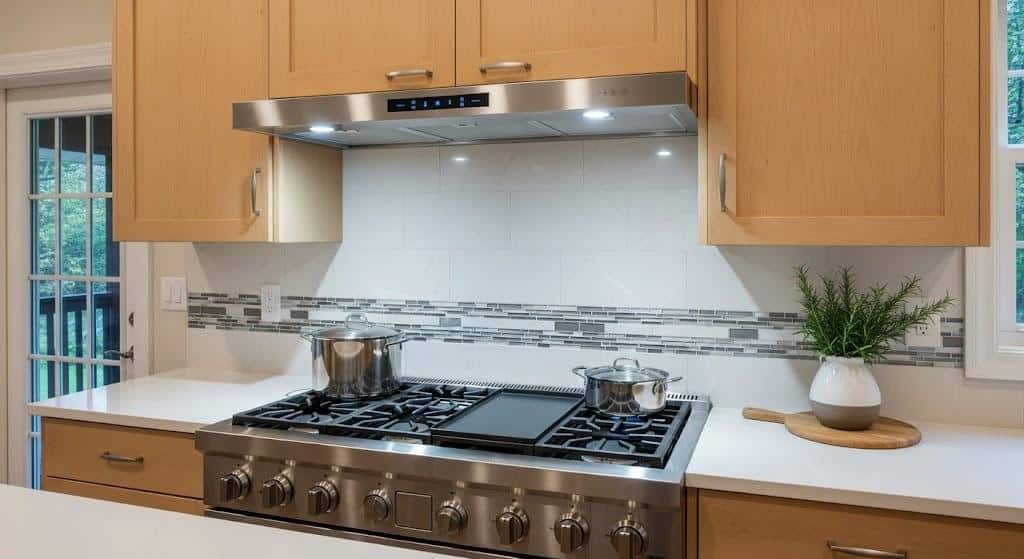
Space-saving design: Under-cabinet exhaust fans fit perfectly beneath existing cabinets. This small kitchen range hood design saves space while providing adequate ventilation for compact cooking areas.
Popular in compact kitchens: Perfect for apartments, condos, and small homes where every inch counts. The low-profile design keeps cabinets accessible while adding ventilation power.
| Pros | Cons |
|---|---|
| Saves valuable kitchen space | Limited power compared to larger units |
| Less expensive than other types | Fewer style options |
| Easy installation | May not cover wide cooktops fully |
| Doesn’t block sight lines | Can be noisy due to compact fan size |
3. Island Range Hood
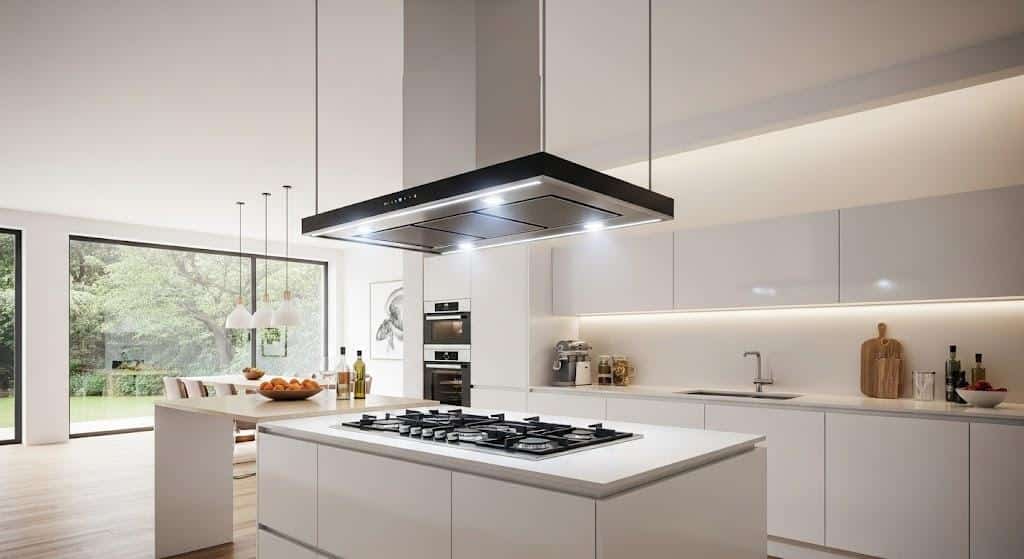
Suited for open-plan kitchens: Island kitchen exhaust fans hang from the ceiling above kitchen islands. They work perfectly in open layouts where the stove sits away from the walls.
Statement piece styling: These island range hoods often become focal points with bold designs, modern materials, and eye-catching shapes that complement open kitchen concepts.
| Pros | Cons |
|---|---|
| Creates a stunning visual impact | Most expensive option |
| Works with any island layout | Complex ceiling installation required |
| Powerful ventilation from all sides | May obstruct views across the kitchen |
| Modern, open kitchen appeal | Needs strong ceiling support |
4. Downdraft Range Hood
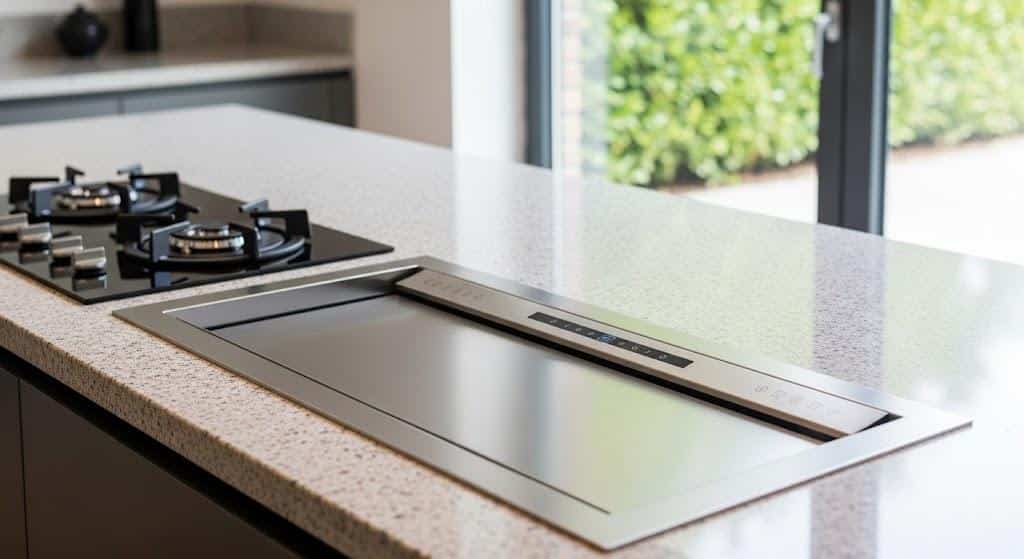
Pulls air downward through retractable vents: Downdraft ventilation systems rise up from behind or beside your cooktop when needed. They pull smoke and steam down through vents in the countertop.
Great for minimalistic designs: This retractable range hood stays hidden when not in use, maintaining clean lines and unobstructed views in modern kitchens.
| Pros | Cons |
|---|---|
| Completely hidden when not in use | Less effective than overhead systems |
| Perfect for kitchen islands without overhead space | More expensive to install |
| Doesn’t block views or lighting | Requires special countertop modifications |
| Modern, sleek appearance | Limited cooking coverage area |
5. Insert Range Hood
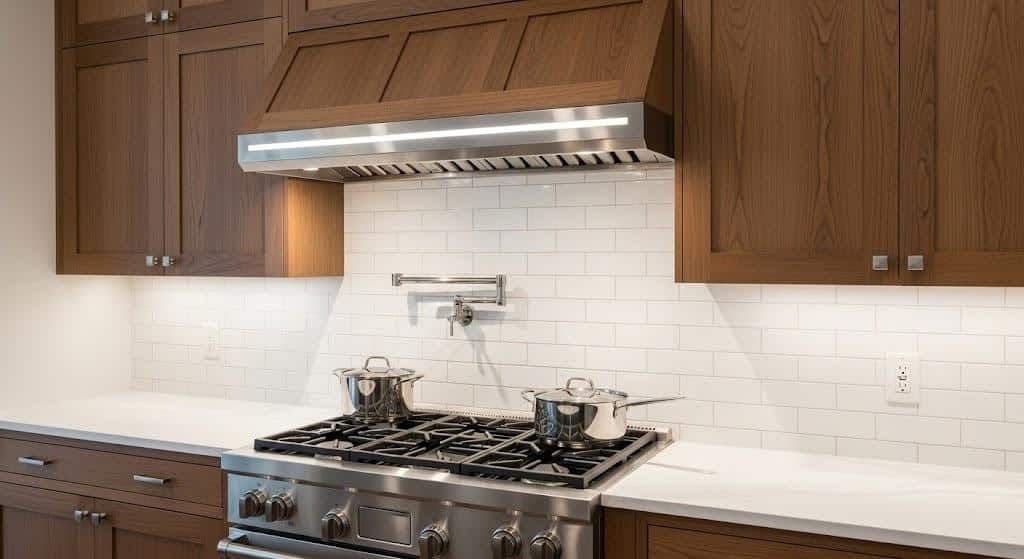
Hidden inside custom cabinetry: Built-in range hoods get completely concealed within custom cabinet designs. Only the control panel and filters remain visible beneath the cabinet.
Luxury kitchens: This cabinet insert exhaust fan option is popular in high-end kitchens where seamless design integration matters most.
| Pros | Cons |
|---|---|
| Completely custom appearance | Requires custom cabinet work |
| Matches any cabinet style | Most expensive installation |
| Professional, built-in look | Limited access for maintenance |
| Powerful ventilation options are available | Complex design planning is needed |
6. Ducted Range Hood

Vents air outdoors for maximum effectiveness: Ducted kitchen exhaust systems connect to external vents that remove all cooking odors, smoke, and moisture from your home completely.
Best for high-heat cooking: External venting makes ducted systems the most effective choice for serious cooks who frequently use high heat, frying, or grilling indoors.
| Pros | Cons |
|---|---|
| Most effective odor and smoke removal | Requires external wall or roof access |
| No filter replacement needed | More complex installation |
| Handles heavy cooking loads | May need professional ducting work |
| Removes moisture completely | It can’t be used in all locations |
7. Ductless (Recirculating) Range Hood
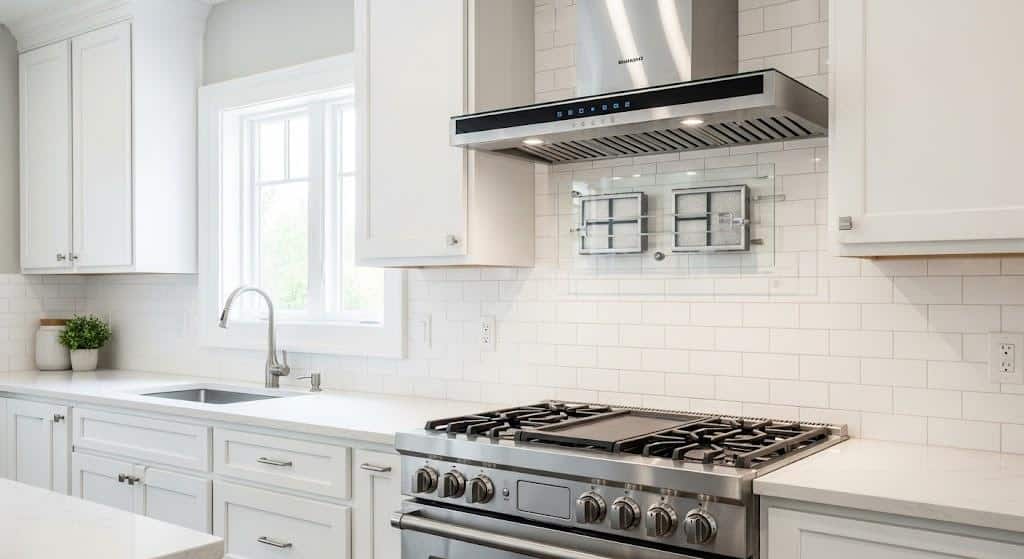
Uses filters to clean air before recirculating: Ductless exhaust fans pull cooking vapors through charcoal and grease filters, then send cleaned air back into the kitchen.
Easy install in apartments: Recirculating range hoods work perfectly in rentals, condos, and homes where external venting isn’t possible or allowed.
| Pros | Cons |
|---|---|
| No external venting required | Less effective than ducted systems |
| Easy installation anywhere | Requires regular filter changes |
| Good for apartments and rentals | Doesn’t remove heat or humidity |
| Lower installation costs | Higher long-term filter costs |
8. Commercial-Style Range Hood

Professional power & large size: Commercial range hoods bring restaurant-grade ventilation power to home kitchens with oversized fans and industrial-strength construction.
Ideal for gourmet cooking: Heavy-duty kitchen exhaust systems handle the intense heat and smoke from professional cooking equipment and frequent high-temperature cooking.
| Pros | Cons |
|---|---|
| Maximum ventilation power | Very expensive |
| Handles any cooking style | Requires significant space |
| Professional kitchen appearance | It may be too powerful for everyday cooking |
| Built for heavy daily use | Professional installation required |
How to Maintain Your Kitchen Exhaust Fan
- How often to clean filters: Clean grease filters every 1-2 months or when they appear dirty to maintain proper airflow and prevent fire hazards.
- Checking ducts for blockages: Inspect external vents quarterly for bird nests, debris, or lint buildup that can reduce ventilation efficiency.
- When to replace filters in ductless models: Replace charcoal filters every 3-6 months, depending on cooking frequency and odor effectiveness.
- Clean the fan blades and motor housing: Wipe down fan blades monthly with degreasing cleaner to prevent buildup that causes noise and reduces performance.
- Test the lighting and controls: Check hood lights and speed controls monthly to ensure they work properly and replace bulbs as needed.
- Professional duct cleaning: Schedule professional duct cleaning every 2-3 years for ducted systems to remove deep grease buildup and maintain peak performance.
How to Choose the Right Kitchen Range Hood
Start by evaluating your cooking intensity: heavy frying and high-heat cooking need commercial-style or ducted systems, while light cooking works with under-cabinet models.
Next, consider your kitchen layout: wall stoves suit wall-mounted hoods, islands need ceiling-mounted or downdraft systems, and compact spaces benefit from under-cabinet designs.
Match your budget to realistic options: under-cabinet and ductless models cost the least, while island and commercial styles require a higher investment.
Finally, check your venting capability: homes with external wall access can use ducted systems for best performance.
In contrast, apartments or houses without venting options should choose ductless recirculating models that filter and return clean air to the kitchen.
Final Thoughts
Choosing the right kitchen exhaust fan protects your home from smoke, grease, and odors while keeping your family healthy.
Each of the eight range hood types we covered serves different needs and budgets. For small kitchens, under-cabinet models offer space-saving ventilation. Heavy cooks benefit from ducted or commercial-style systems.
Island kitchens need ceiling-mounted hoods, while apartments work best with ductless recirculating models.
Remember to consider your cooking habits, kitchen layout, budget, and venting options before making your final choice. Regular maintenance keeps any system working effectively for years.
What’s your biggest challenge when choosing kitchen ventilation? Share your questions in the comments below, and don’t forget to measure your space before shopping.
Cooking up style? See more kitchen and dining ideas worth saving.
Frequently Asked Questions
What Is the Difference Between a Type 1 and Type 2 Vent Hood?
Type 1 hoods handle grease and smoke from cooking equipment, while Type 2 hoods remove heat and steam from dishwashers and ovens.
What Are the Different Types of Range Hood Blowers?
Range hood blowers come in centrifugal (powerful, quiet), axial (basic, affordable), and inline/remote (mounted away from the hood for reduced noise).
What Is the Difference Between a Vent Fan and a Range Hood?
Vent fans simply move air around the room, while range hoods capture cooking vapors directly at the source above your stove and filter or vent them outside.
What Are the Different Types of Blowers?
Blower types include centrifugal (high power, quiet operation), axial (basic airflow, lower cost), inline (remote-mounted for noise reduction), and external (mounted outside for maximum quiet).

